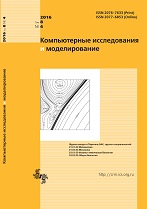|
MODELS OF ECONOMIC AND SOCIAL SYSTEMS
Impact of the non-market advantage on equilibrium in a Hotelling model
A. I. Kosacheva
Financial University under the Government of the Russian Federation, Faculty of Applied mathematics and information technologies, 49 Leningradskiy prospect, Moscow, 125993, Russia
Abstract:
The principle of minimal differentiation, based on the Hotelling model, is well known in the economy. It is applicable to horizontal differentiated goods of almost any nature. The Hotelling approach to modeling competition of oligopolies corresponds to a modern description of monopolistic competition with increasing returns to scale and imperfect competition. We develop a modification of the Hotelling model that endows a firm with a non-market advantage, which is introduced alike the valence advantage known in problems of political economy. The non-market (valence) advantage can be interpreted as advertisement (brand awareness of firms). Problem statement. Consider two firms competing with prices and location. Homogeneous consumers vary with its location on a segment. They minimize their costs, which additively includes the price of the product and the distance from them to the product. The utility function is linear with respect to the price and quadratic with respect to the distance. It is also expected that one of the firms (for certainty, firm № 1) has a market advantage d. The consumers are assumed to take into account the sum of the distance to the product and the market advantage of firm 1. Thus, the strategy of the firms and the consumers depend on two parameters: the unit t of the transport costs and the non-market advantage d. I explore characteristics of the equilibrium in the model as a function of the non-market advantage for different fixed t. The aim of the research is to assess the impact of the non-market advantage on the equilibrium. We prove that the Nash equilibrium exists and it is unique under additive consumers' preferences depending on the square of the distance between consumers and firms. This equilibrium is ‘richer’ than that in the original Hotelling model. In particular, non-market advantage can be excessive and inefficient to use.
Keywords:
Hotelling model, Nash equilibrium, non-market advantage.
Received: 03.02.2016
Citation:
A. I. Kosacheva, “Impact of the non-market advantage on equilibrium in a Hotelling model”, Computer Research and Modeling, 8:3 (2016), 573–581
Linking options:
https://www.mathnet.ru/eng/crm12 https://www.mathnet.ru/eng/crm/v8/i3/p573
|

| Statistics & downloads: |
| Abstract page: | 176 | | Full-text PDF : | 81 | | References: | 27 |
|




 Contact us:
Contact us: Terms of Use
Terms of Use
 Registration to the website
Registration to the website Logotypes
Logotypes









 Citation in format
Citation in format 